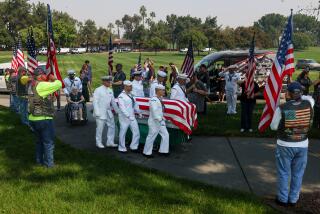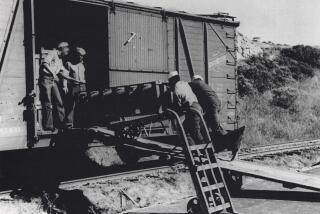Breaking the Silence : Military: Were 50 black sailors wrongly convicted of mutiny after a 1944 explosion that killed 320 men? Some of them say yes--and they want their names cleared.
- Share via
SAN FRANCISCO — On the night of July 17, 1944, Seaman 1st Class Robert Routh settled into his top bunk in a barrack at the Port Chicago Naval Magazine, about 30 miles east of Oakland. The 19-year-old had skipped leave in San Francisco to write letters, do laundry and save money for a trip home.
In a nearby barrack, Seaman 1st Class Joseph Small stretched out after an exhausting day of dockside duty. Hundreds of sailors were working around the clock to load two Liberty- and Victory-class munitions ships, bound for the war in the Pacific.
Other black sailors, many of them friends, worked into the night as Small tried to sleep.
They were men who would never finish their shifts.
The first of two explosions ripped open the night shortly after 10:18 p.m. “It was the biggest and the brightest Fourth of July coloration you’ve ever seen,” says Routh, now 66, who was blinded by flying glass.
Then came the second blast, which also rocked Small’s barrack, one of a cluster a mile from the dock. “The explosion lifted me and my mattress off the bunk,” Small says. “I unconsciously gripped the edge of the mattress. I landed on the floor with the mattress on top of me. A lot of the falling glass was caught by the mattress. I’d have been butchered if (the mattress) hadn’t fallen on me.”
There were hundreds of sailors working on the docks, and most of them were killed or wounded; a few casualties were reported in the nearby town of Port Chicago. In all, 320 men died, 390 were injured. A majority of the casualties were African-Americans. During that era of segregation in the armed forces, blacks tended to be assigned to manual labor, including the loading of munitions.
The Quinalt Victory and the E. A. Bryan, two of the ships in the area, were tangles of metal; the dock, heaps of splintered wood. The force of the blasts destroyed the town of Port Chicago, scattered unexploded bombs miles from the harbor and registered on seismographs as far away as Nevada. It was the worst war-related disaster in the continental United States.
Some Navy investigators suspected sabotage; others hinted that sloppiness, bad training or equipment failure caused the calamity. In the end, 50 black sailors were convicted of mutiny because they refused to return to work until safety measures were implemented.
According to sociologist Robert Allen, who has written a book on the disaster, the incident helped inaugurate the desegregation of the Navy that started in 1945.
But for the Port Chicago 50, that movement meant little. They served brief prison terms, were sent to sea for a year without leave, received less-than-honorable discharges and were refused veterans’ benefits.
Now the surviving sailors want their names cleared.
Last May, the House passed a resolution, written by Rep. George Miller (D-Martinez), directing the secretary of the Navy to review the case and the extent to which racial prejudice or “other improper factors” may have tainted the original investigations and trials. The directive is under review by the Senate Armed Services Committee. If it is signed by President Bush, it’s up to the Navy secretary to determine how or if the sailors might be compensated.
“It’s an American tragedy,” says Allen, who wrote 1989’s “The Port Chicago Mutiny: The Story of the Largest Mass Mutiny Trial in U.S. Naval History.” “It was the world as it was, and it was pretty grim. These guys were victims of racism and the military legal system. They were railroaded into jail. There was no mutiny. It was simply a wildcat strike.”
Port Chicago, now part of the Concord Naval Weapons Station, was a sweltering and desolate outpost. The young black sailors, under the command of white officers, worked around the clock to load munitions.
The job produced jagged nerves, sore joints and distrust, according to the men who survived. The sailors lifted, rolled and stacked everything from eight-foot shells for battleships to two-ton bombs that pounded the enemy into oblivion.
“We were just shown a boxcar full of ammunition, wire nets spread out on the docks and the hole in the ship and told to load,” recalls Small, 69, of Somerset, N.J. “Our greatest beef was that we were given no instructions. No one talked about the dangers we believed existed, and we were green, right out of boot camp.”
In a ship’s belly, the air is hot, sticky and stagnant. Bombs, slathered in grease, tumbled down ramps to awaiting sailors.
“Sometimes, you wouldn’t catch them because they were coming down too fast and they would hit together,” recalls Freddie Meeks, a 71-year-old Los Angeles resident and one of the Port Chicago 50. “They would make a big noise and scare you to death.”
“I believe if we had been white, they would have given us some sort of instructions on how to handle the ammunition safely,” says Small, who was accused of leading the mutiny.
According to Allen’s book, during an investigation of the explosions, a Navy judge advocate quoted white officers as saying: “The colored enlisted personnel are neither temperamentally (nor) intellectually capable of handling high explosives.” Allen based much of his book on official records from the Navy transcripts of an investigation of the explosions and the later courts-martial of the Port Chicago 50.
On Aug. 9, three weeks after the explosions, the survivors were ordered to fall in for a new work detail at nearby Mare Island, where another munitions ship, the San Gay, was berthed awaiting ammunition.
Survivors say black sailors, mourning the death of comrades, were stung by fear and frustration after being denied the 30-day leaves white survivors received.
“I thought we were treated pretty unfairly,” says Percy Robinson, 66, a retired engineer who lives in Los Angeles and who was a seaman 1st class at the time. “My face was mutilated. When you passed the mirrors, the skin was hanging off your face and you couldn’t recognize yourself. After you were wounded, you were supposed to go home for leave. After we were wounded, they made us go back to work. That’s why I struck.”
Small called cadence that day for the men of the 4th Division.
“At the end of the street was a podium,” he recalls. “Right was toward the parade grounds, left was toward the docks. When the lieutenant said, ‘Column left!’ everybody stopped dead in his tracks. He called me up front. He said, ‘Small, are you going to work?’ I said, ‘No sir.’ When I said ‘No sir,’ somebody in the ranks behind me said, ‘If Small doesn’t go, we’re not going.’ ”
Initially, 258 men refused to work and were imprisoned on a barge for three days. Rear Adm. Carleton H. Wright gave the sailors a stern warning.
“He said, ‘If you don’t go back to work, you’ll be charged with mutiny, and mutiny is punishable by death, by firing squad’,” recalls Robinson, who was among those who backed down. “He asked us again, ‘Will you go back to work?’ Everybody said yes, except 50 guys.”
“That didn’t turn the 50 sailors,” Meeks says. “When it came time to decide, they said, ‘Those who want to go to work, step to the left. And those who don’t want to work, step to the right.’ So we stepped to the right. We said, ‘If we’re going to be shot, we’ll be shot.’ We were not going back to those conditions. I wouldn’t call that mutiny. It was just a refusal to load ammunition.”
Sailors who agreed to work were interrogated to provide evidence against the 50. Those who agreed to go back to work received summary courts-martial and were sentenced to three months’ hard labor; eventually, however, they were granted honorable discharges. The Port Chicago 50 went to Treasure Island, a Naval installation in the Bay Area.
The courts-martial started Sept. 14. A young attorney named Thurgood Marshall, chief counsel for the NAACP, had arrived to defend them.
“He told us the public was in our favor and there was a lot of sentiment against the trial,” Small recalls. “He told me he was going to Washington to put in a formal protest against the Navy.”
During the six-week proceedings, Marshall became enraged, according to Allen’s account.
“This is not 50 men on trial for mutiny,” Marshall told the press. “This is the Navy on trial for its whole vicious policy toward Negroes. Negroes are not afraid of anything any more than anyone else. Negroes in the Navy don’t mind loading ammunition. They just want to know why they are the only ones doing the loading! They want to know why they are segregated; why they don’t get promoted.”
On Oct. 24, the Navy trial board, after only eight minutes of deliberations, declared the Port Chicago 50 guilty of mutiny. Sentences ranged from eight to 15 years in prison. The sailors also were busted to the lowest rank: seaman apprentice.
“I considered myself blessed,” says Small, who received a 15-year sentence. “I could have been sentenced to death.”
The black community and liberal white groups decried the convictions. First Lady Eleanor Roosevelt appealed to Secretary of the Navy James V. Forrestal. But the findings stuck.
The sailors were taken by train to the Terminal Island Disciplinary Barracks in San Pedro, where they remained for 16 months. Then the men were sent to sea but were denied shipside duties and liberty at ports of call.
A year later, the convicted sailors were quietly released from captivity and discharged “under honorable conditions”--a step above dishonorable discharge, but one that nevertheless negated veterans’ benefits.
No one knows how many of the Port Chicago 50 are alive today; only a handful have been accounted for.
“Many of them have made their peace with it and tried to forget it,” Allen says. “Others are still traumatized by the experience. They still feel ashamed.”
Most remained silent.
“I kept all those things inside of me,” Meeks says. “I didn’t want to hurt my family. We were supposed to be bad people. People would turn their thumbs down on you. I was pretty bitter about it.”
Now Meeks wants to correct the record.
“I hope that all of America knows about it,” he says. “It’s something that’s been in the closet for so long.”
The Navy has no official opinion on the incident or on the proposal to reopen the case. Lt. Mark Walker, a Navy spokesman at the Pentagon, said: “It’s in the hands of the Congress. If we’re directed to reopen the investigation, to look at the facts again, we will do that. But that’s as far as we can go.”
Rep. Miller says the Navy owes the survivors a review of their cases. “In this case, you read the documents, you talk to the men and you feel justice wasn’t done.
“If things work out right with this challenge to have the record corrected, it will prevent the next generation from repeating that tragedy.”
More to Read
Sign up for Essential California
The most important California stories and recommendations in your inbox every morning.
You may occasionally receive promotional content from the Los Angeles Times.










